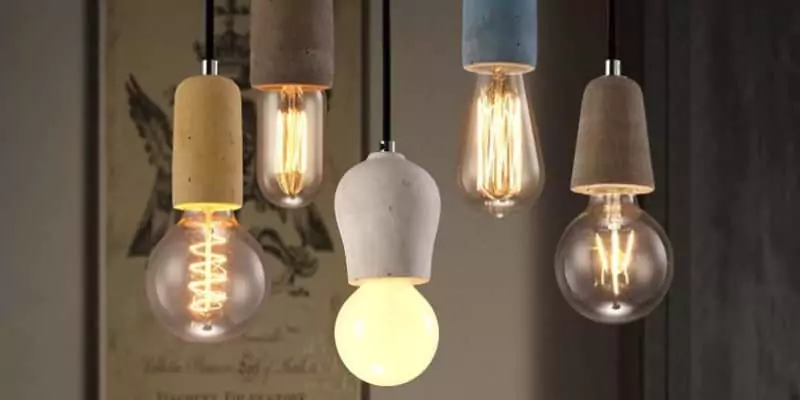
Things To Consider When Choosing a Led Bulb
One of the main features of LED Bulbs is that they are energy efficient. About 25% of the energy consumed in a house is due to electricity used for lighting. LED bulbs, which consume less electricity, have replaced incandescent bulbs today and have been applied for different decorative purposes in residential and commercial projects. So, how to choose LED bulbs? What should be paid attention to? By reading the information we provide about LED bulbs, you will have the most accurate information about which models you should choose.
How Do LED Bulbs Work?
Before deciding which LED lighting model to buy, it's important to be familiar with how LED bulbs work. LED bulbs are bulbs that consume less electricity, last longer than incandescent bulbs, and are more powerful in terms of lighting quality.
While conventional bulbs consume more power to produce light, LED bulbs have conductive properties that facilitate the passage of the energy that creates the light. Thus, they ensure that sufficient light is produced with less energy. In addition, since incandescent bulbs consume more energy, heating problems occur on the glass surface after a while.
Advantages of LED Bulbs
LED bulbs have many advantages and save you money on the electricity bill. However, in addition to this, using them brings many other benefits. They are more ecological than other types of bulbs, consume 70% to 80% less than incandescent bulbs and 30% less than fluorescent bulbs, and are more resistant to impacts. Other advantages include having a longer service life, not emitting UV rays, activating immediately, and not needing to be heated.
- LED bulbs start to emit light very quickly. Lighting occurs as soon as you touch the button.
- They have a long service life, except for places that are overheated. A LED bulb can achieve a lifespan of 50,000 hours, compared to 10,000 hours for low-energy bulbs. Therefore, you save not only in energy consumption, but also in the number of light bulbs you will have to buy.
- They do not contain mercury or polluting gases.
- LEDs have many different designs. This offers a rich choice in terms of decorative lighting.
- LED lighting produces a uniform light that is not dazzling and therefore is less tiring on the eyes.
- Their Color Rendering Index (CRI), i.e. similarity to natural light, is higher than low-energy bulbs.
How to Choose LED Bulbs for Saving Energy?
When deciding which LED bulb to replace incandescent or conventional energy-saving bulbs, design, outlets, or prices aren't the only things you need to consider. Here are the features you should consider when choosing a LED bulb:
Power: It is measured in watts and is the amount consumed by the bulb. For LED bulbs, the relationship between power and the amount of light they produce is not as direct as for other categories. The lower it is, the less the bulb consumes.
Equivalence in watts: This characteristic is the equivalent power of an incandescent lamp with the same light output.
Energy efficiency class: Like household appliances, this is a visual way of knowing how efficient a light bulb is.
Lumen/w efficiency: Lumen is the unit used to express the amount of light a bulb can produce. LED bulbs consume fewer watts compared to incandescent and other bulbs, producing more lumen light.
Useful life: Indicates the number of hours the LED bulb will work correctly. Another factor to consider when purchasing LED bulbs to save on your electricity bill is durability. This value refers to the light hours provided by the bulb, which can vary between 15,000 and 50,000 hours, depending on the brand and model.
Number of revolutions: This number shows how many times we can turn the bulb on and off before it starts to fail.
Ignition/preheat time: The time it takes until the bulb reaches 60% of its brightness. When it comes to LED bulbs, it's usually instantaneous.
Maintenance factor: It is the percentage of luminous flux that the manufacturer provides at the end of their useful life under specified conditions. A figure of 0.7 is usually sufficient.
Being dimmable: If we are going to use the bulb with a dimmer, it is necessary to make sure that it is compatible. Thanks to dimmable LED bulbs, the brightness of the home light can be adjusted and a different atmosphere can be provided to the home environment.
Color temperature: It is measured in degrees Kelvin and corresponds to the hue of light from a light source. The higher it is, the cooler and bluer the white light source appears. A bulb's color temperature can be warm (yellow light) or cool (white light) and is expressed in degrees Kelvin, which can range from 3,000 (warm) to 6,500 (cold).
Yellow light provides the perfect ambient lighting to create a relaxed and friendly atmosphere. Therefore, it is suitable for rooms where we rest and relax, such as the bedroom, living room, and dining room.
White light, on the other hand, is more stimulating and gives us more brightness and less strain on the eyes. Choose this color temperature for the LED bulbs you will place in the kitchen, bathroom, study rooms, and outdoors.
Rendering index: This feature, which is one of the strengths of LED bulbs, is related to the quality of the light. It represents the reliability of light compared to natural light. It is displayed on a scale from 0 to 100, and the higher it is, the better the quality of light that the LED bulb provides us. It should be at least 80.
Light angle: It is the opening angle of the light beam. Depending on the type of lighting we're looking for (wider or more intense), this should be the case.
What are the Differences Between LED and Energy-Saving Bulbs?
Both models produce the same light, consuming less electricity than traditional bulbs. So, it is possible to save on electricity bills with both LED bulbs and low-energy bulbs. Both use energy efficiently.
LED bulbs have a longer lifetime than energy-saving bulbs. Therefore, although LEDs are more expensive than low-energy ones and therefore involve a higher initial expenditure, they are more profitable in the long run.
The main disadvantage of energy-saving bulbs is that they contain polluting gases and mercury, unlike LED bulbs. Therefore, they are considered hazardous waste.
Tips for Choosing and Buying LED Bulbs
LED bulbs differ in the number of LEDs they contain, from 3 to 20 series, among other qualities. The material the LEDs are made from is also important because the more active material it has, the more light it emits. But this also means more costs.
The most purchased bulb model for homes and offices is usually 3 or 5 LED lighting, and it is a high-intensity bulb that offers enough light for the average indoor use. If you have 20 LEDs but their intensity is low, and if one of them breaks, the others will gradually break, and the life of the bulb will be reduced.
Cheap LED bulbs are usually those with few LEDs and very low intensity, so they are the least efficient.
In order to know how to choose the LED bulb we need, we need to consider many features such as lumen power, lamp head, light opening angle, light temperature, and whether it is suitable for our use.
Choose the Right LED Lighting Manufacturer!
Besides analyzing all the technical specifications of LED bulbs, an important factor is choosing a provider that provides security and professionalism, whether it's a physical or online store.
As Turkey's leading manufacturer of LED lighting systems, Valens makes your life easier with environmentally friendly LED lighting products produced at high standards. You can review our rich product range for all your lighting needs.


